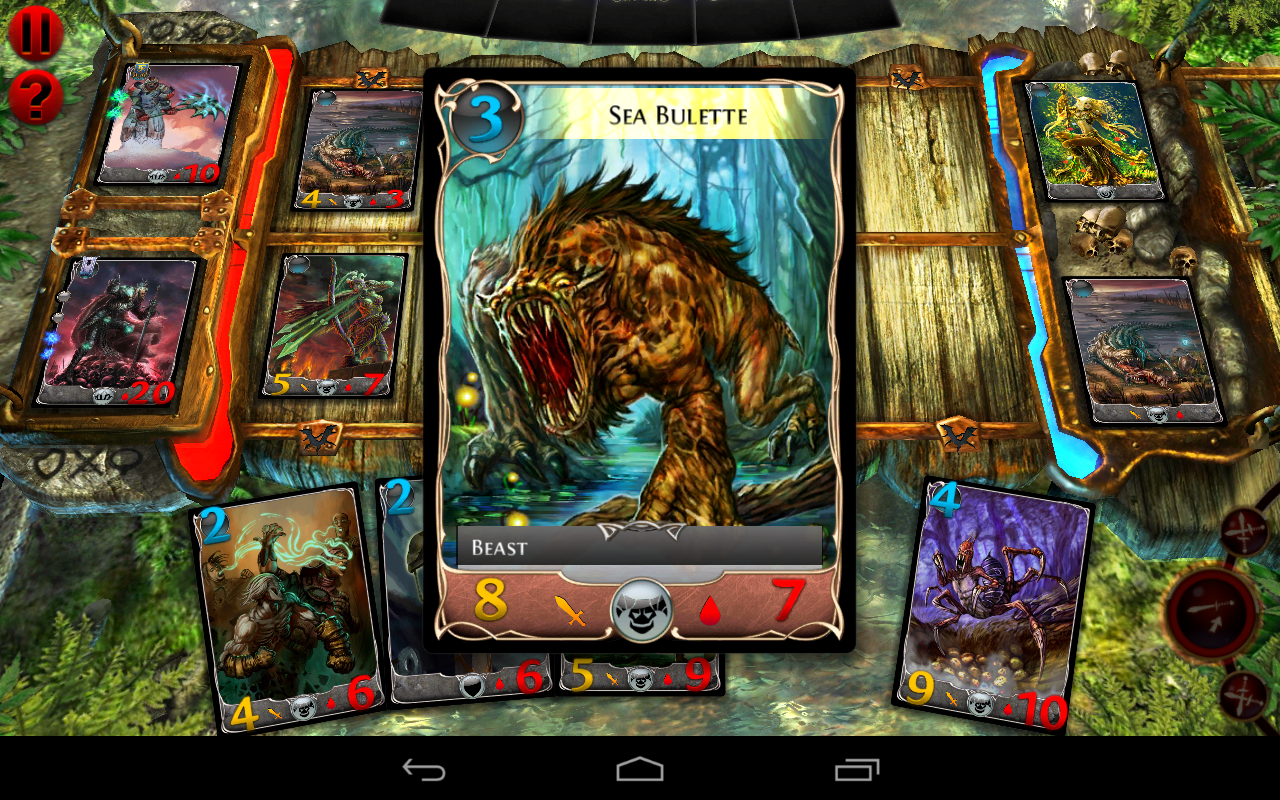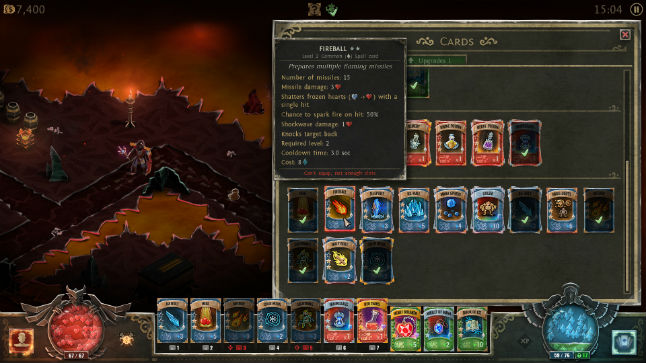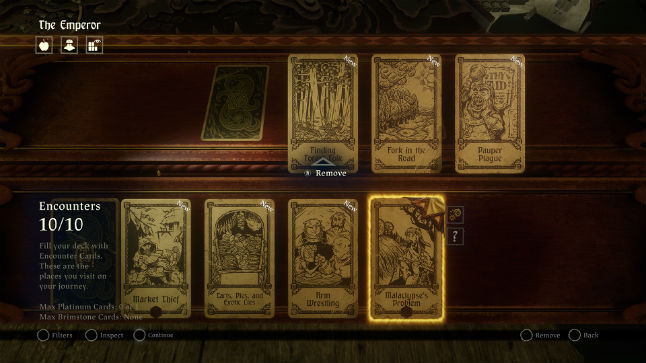Video game deckbuilding design
- Transfer

Card games and deckbuilding (deck building) elements have been used in video games for a long time, sometimes mixing with well-known genres to create a new, but at the same time familiar gameplay. Developers experiment with this subgenre in various ways, either by creating completely randomized systems, or by going the hard way of trial and error.
We talked with different developers about their experience in creating a building design and asked for advice for those who want to implement such systems in their own projects.
Familiarity of elements as a tool
Game project director Peter Johansson and lead designer Robert Olsen of Image & Form Games , a SteamWorld game development studio , call traditional RPGs the main source of magic and appeal for collectible card games.
“The sensations we get from games like Magic: the Gathering, Hearthstone and Netrunner are similar to the sensations from the classic RPG: we take on the role of a hero equipped with magic spells and weapons (or hacker tools in cyberspace) to defeat a powerful enemy. Card games take this fundamental gameplay and put it in a different package, changing the perspective and ways of interacting with what is familiar to the players. ”
When creating maps for SteamWorld Questdesigners strive to make them easily recognizable, even if the player does not yet know in detail about their properties. If a player sees a card called "Heroic Strike" with a sweeping sword, he will probably understand what she is doing. But at the same time, Peter and Robert say that for such games one of the most important elements is gradualism. It is important to know when it is time to introduce new cards so as not to overload the player immediately.

SteamWorld Quest
“Difficulty must increase fast enough so that the player is constantly interested and wants to learn more, but not so fast that it bores him. This is especially important when we introduce new player-driven characters, because we want them to immediately appear attractive and unique, while the player is not overwhelmed with new concepts. Balance here is very difficult to maintain. ”
In the development process, Johansson and Olsen faced another problem - the players were not interested in experiments with the interaction of cards and their collection for the future, but instantly used what came into the deck. Taking the Fate / Grand Order as an example, the developers came up with a chain system that gives bonus effects in each turn if players use a certain combination of cards. This system later evolved into Heroic Chains: using three cards of one hero in one turn.
“Be prepared for having to experiment a lot,” they add. “It is important to remember that deckbuilding is also a form of gameplay. Players will spend a lot of time in the UI, thinking over the cards in their collection, mentally trying different ideas, collecting decks that seem powerful or interesting to them, and only after that they will go on to real battles. "Do not limit your ability to balance cards with just a few variables and do not select schemes that cannot be configured."
Key to Success - Experiments
Thing Trunk co-founder and chief gaming architect Maciej Bedzicki and his team spent a lot of time finding the right balance. They sought to make the design of Book of Demons simple, but not too primitive. So they arrived at the basic idea of dividing cards into three categories: skills, items, and spells.
“Such a system is not only easier to explain to players; it gives them more options for strategies, ”Bejitsky explains. "The choice between an item and a spell in a limited number of card slots is interesting."
But creating a card balance was also a long and complicated process. In Book of DemonsThere are 40 archetypes of cards (not counting upgrades, magic or legendary options) for each of the three game classes. If we take into account the various interactions that players can create between different cards, it is almost impossible to achieve the absence of too powerful combinations. “A player can equip up to 10 cards, and this seems like an acceptable number, but if you use combinatorics, we get 3 quadrillion possible combinations.”

Book of Demons
Two and a half years of “early access” was a critical time for developing Book of Demons deck designs. It allowed developers to make hundreds, if not thousands of changes, and some cards were even recreated from scratch. Along with finding too powerful or weak cards and combinations, Thing Trunk wanted to provide more depth for hardcore players, which led to the creation of an upgrade system.
“Embedding a card system in a game is an exciting process that allows you to use more abstract rules,” says Bedzhitsky. “But this is by no means a magical solution that can improve any game. If you think that there is a place for a card system in your game, then I recommend making a quick prototype to check how it works. The game should become interesting already with a few simple maps. If this is not so, then it’s worth returning to the design stage: the system cannot be made to work by simply adding more cards with exotic effects to it. ”
The idea of using cards in Slay The Spire came to the co-founder and developer of Mega Crit GamesAnthony Giovanetti because he himself loved them. Thanks to games such as Magic: The Gathering and Dominion, he has become a fan of de-building. At the same time, the roguelike-aspects of the game became, from the point of view of mechanics, a logical justification for why the player constantly receives new cards added to his deck. Also a source of inspiration were draft formats, for example, from the arena mode in Hearthstone.
“Fighting on the cards is a fundamental part of the idea of the game. Therefore, I don’t think that we had any particularly difficult problems in this area, ”says Giovanetti. "If you look at the battle in Slay the Spire as an analogue of the battle in JRPG, then the cards turned out to be a huge and easy advantage in terms of increasing the depth of the turn-based battle round."
In this project, Early Access demonstrated that players have always demanded reinforcement of cards, and it was important to take this into account when making all kinds of changes to them. To maintain balance, you need to take such offers realistically and rely on data. “Players can let you know that the card doesn’t suit them, but they cannot decide whether it is good or bad.”
From the very beginning, register cards in the database
Thanks to the feedback from the players, the Daily Challenges have also undergone strong changes in the development process. At first, they were supposed to be assignments showing how far the players could advance in them. But in the end, they decided it was better to use fancy modifiers. Players could still compete, but more important now was how they could win in daily tasks, rather than just trying to complete them.
“Maps open up a huge space of opportunities, so you need to collect data on them and playtest at the very early stages of development, otherwise the balance will be terrible,” adds Giovanetti.
Liaison manager and designer Lee Mei from Defiant says Hand of Fate is in developmenta key element was balancing the player’s influence on the game. It started with a previous Heroes Call mobile project that used randomness to create dungeons, but the player never saw this because all the generation was done in the background. After thinking about this, May said that Defiant could probably save a lot of time by creating a linear gameplay manually, without using procedural generation.

Hand of Fate 2
“When we started exploring deckbuilding, we discovered a wonderful thing - the game process can be randomized anyway, but you can engage a player in this and give him a sense of influence on this randomization and its management,” May explains. “The deck replaces the dungeon master, and is not a player’s squad or combat moves. That is, the lessons we learned during the development process are quite specific and less applicable in games like Gwent , Hearthstone or Slay the Spire . "
Creative Director Morgan Jeffit takes into account what happened with Heroes Calland decided to go the difficult way again: all cards are shuffled and taken from the internal base, and not completely randomized. It is curious that this decision was influenced by his previous experience as a magician.
“All cards are physical objects, like their decks, so when a game needs to search in a deck, we actually shuffle the stack of game objects until we find the required card. It would be infinitely easier to imitate all this, but we refused to do so, because this is the prestige of a magician. Of course, this is crazy - magicians are known for cheating with cards, but we decided to choose this path. "
Work experience on both parts of Hand of Fatestaught them the importance of tracking everything and keeping it in a constantly up-to-date database. “We also know that a power creep is inevitable, especially if you add content in waves, so get ready for a multiple balance review,” says May. "Keep in mind that there is such a problem as having too many choices - if you give the player the opportunity to choose five cards from the deck, this will lead to a much more interesting decision-making process than if he had a choice of twenty cards."
Game designer and screenwriter Alexis Kennedy, based on his experience working with Weather Factory ’s Cultist Simulator , can also share useful tips for studios who want to focus on a verbally abstract card-based gameplay.
From the point of view of art, the main priority should be the search for an artistic style that is both unique and cheap to create. And when you start adding text to cards, always pre-evaluate its appearance. “Solving the problem of detailed information on maps is the main difficulty in creating a UI,” Kennedy says. "It is not enough just to put this text into the tooltips."

Cultist Simulator
Players' expectations require careful monitoring of potential problems that may cause cards to be stacked. For example, you need to monitor what happens when a card returns to an already non-existent deck, what happens when the second card comes back and is put on the previous one, and check if the properties of the card have changed. In addition, if most cards are permanent, then when they are destroyed, players will react more actively.
Kennedy shares his worries about the position snapping functionality to the grid and talks about how important this turned out to be for the gameplay as a whole. “I can’t believe that we released the game without tying the cards to the grid. I wanted the UI developer to leave this at the last moment, but he did not have enough time due to working with sound effects. It was necessary to free him from this work and put the binding function much higher in the list of priorities. "About the third day after the release of the game, one of the players added a mod that includes binding."
“The feedback we collected generally came down to the fact that players want the cards to fit in the right place without any problems. Of course, this is a typical UI problem: each player has his own idea of what the “right place” is, ”he explains. “We implemented simple elements in the game to cope with this problem, but I think that in the next game we need to approach this issue from the other side - to make the unfolding of cards have obvious value and importance in the game.”
